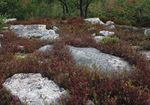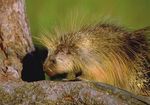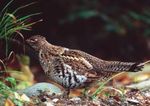PENN'S WOODS NATURE'S WATER PURIFIER
←
→
Page content transcription
If your browser does not render page correctly, please read the page content below
Spring/Summer 2010
Seasonal News for Pennsylvania
Supporters of The Nature Conservancy
nature.org/pennsylvania
Penn’s Woods
Nature’s Water Purifier
How forests hundreds of miles away protect what’s coming out of your tap.
Next time you walk through a forest, imagine that the trees are affixed to the end of your kitchen
faucet like a large green purifier, cleaning the water before it splashes, crystal-clear and cool,
into your drinking glass.
It’s hard to think of it that way; a natural forest is a messy thing, a chaotic jumble of plants and
animals blanketed by leaf litter or pine needles. But those who are responsible for safe drinking
water have known for years that source water flowing from forested watersheds is easier and
cheaper to treat than the water that runs off city streets or agricultural fields.
(continued)moosic mountain field guide
What you’ll see at one of our newest preserves.
With the arrival of warm spring days, the new Dick & Nancy Eales Preserve at Moosic Mountain, a 2,250-acre
property with miles of hiking and mountain biking trails located just northeast of Scranton, is the perfect location
for getting out into nature. Dozens of migratory songbirds make spring visits to the area, and rare plants carpet
the forest floor beneath an unusual pitch pine and scrub oak barrens ecosystem.
Pink Lady’s Slipper Cypripedium acaule Northern Harrier Circus cyaneus
Also known as the “moccasin flower,” the pink lady’s slip- This medium-sized hawk can often be seen gliding on the
per is a small, rare native orchid with two leaves and a thermals, currents that flow across the mountain ridges.
three-inch long lightly closed deep pink flower that blooms Its feathers are streaky brown, but this low-flying hunter is
in the early spring under oaks and pines. most recognizable by its long tail, white rump and slightly
rounded wings.
Painted Trillium Trillium undulatum
A low plant displaying a small white flower with a crimson Ruffed Grouse Bonasa umbellus
heart nestled in the center of three dark-green leaves, the Often incorrectly called a partridge, this brown-streaked
trillium blooms in late spring on the forested ridges. game species is Pennsylvania’s state bird. At the peak of
the spring mating season, at dawn, you might see a male
Inland Barrens Buckmoth Hemileuca maia maia fanning his tail and drumming—beating the air with his
You’ll see the rare black-banded moth only when it emerges wings to attract a female. Some say it sounds like a car
from underground pupae in the fall. But throughout the engine starting up.
spring and early summer, its showy larvae, a spiny black
and yellow caterpillar with irritating spines that look like North American Porcupine Erethizon dorsatum
neon anemones, feed almost exclusively on scrub oaks. The state’s second largest rodent, following only the beaver,
averages 10-15 lbs. An adult has 30,000 quills to defend
Black and White Warbler Mniotilta varia itself from predators, but can’t “shoot” its quills and will
This small zebra-striped songbird breeds in Pennsylvania’s attack only if threatened. An herbivore, the porcupine eats
forests each summer and spends its winters as far south as a variety of plants and fruits during the summer and often
Colombia and Venezuela. You may see it creeping along strips trees for their inner bark during the winter.
branches searching for insects, but are more likely to hear —Misty Edgecomb
its very high-pitched two-note song, which some describe
Photos, from top, left to right: Windmills on Moosic Mountain
as sounding like a squeaky wheel. © George C. Gress/TNC, Grouse © Bill Silliker, Jr., Trillium © Alden Warner,
Porcupine © Janet Haas, Moosic Barrens © George C. Gress/TNC,
Black-and-White Warbler © George C. Gress/TNC
on the web » Check out our trail maps, downloadable from the Moosic Mountain preserve page via nature.org/pennsylvania.(continued from cover) because its remaining forested areas serve like French Creek and the Delaware. But
That’s because forest root systems as a buffer for the runoff from agricultural that’s the beauty of protecting forested
absorb nutrients that can spoil water qual- fields in the area. We’re working, in part- watersheds. Conserve the wooded areas
ity, and bind soil together to prevent ero- nership with the Western Pennsylvania that protect our rivers’ headwaters and
sion from polluting streams. Mature trees Conservancy and the French Creek Valley floodplains, and you’re not only protect-
along a river provide shade that moderates Conservancy, to keep it that way. ing water for communities downstream;
water temperature. Protecting forested
floodplains reduces flooding, which in turn
decreases sediment and polluted runoff. So, “Next time you turn on your tap, picture a stream passing
if you want a drink of clear, cool water, look
downstream from a healthy forest.
through a deep, cool forest—nature’s water purifier.”
Forests at Risk
But those healthy forests are threatened
throughout Pennsylvania by unsustain-
able forestry and agricultural practices as
well as poorly planned energy and urban
development. Pennsylvania is experienc-
ing a dramatic increase in energy develop-
ment right now, with hundreds of wind
turbines and natural gas wells being built
in our forests. If these developments aren’t
carefully planned, forests habitats will
be fragmented and we could lose some of
their incredible biological diversity.
And as forests are destroyed, water
quality suffers. That’s one important reason
why The Nature Conservancy is protect-
ing forests along source water streams all
throughout the state. By conserving forested
floodplains, the Conservancy is helping to
protect drinking water sources for millions
© George C. Gress/TNC
of Pennsylvanians.
From the Forest to Your Tap In Eastern Pennsylvania, the Delaware you’ve also preserved habitat for birds,
About 90 percent of Pittsburgh’s drinking River provides drinking water for nearly fish, mussels and other species that rely on
water supply comes from the Allegheny 20 million people, including many of clean streams and healthy forests.
River, and water treatment experts in the residents of Philadelphia and New So next time you turn on your tap,
Pittsburgh say they’ve always known that York City, while in the central part of the picture a stream passing through a deep,
raw water from forested watersheds is state, the Susquehanna provides much of cool forest—nature’s water purifier.
easier to treat. In recent years, regulators the water for the people of Harrisburg. —Randy Edwards
have urged municipalities to pay as much And the Conservancy’s work to protect
attention to the water coming into their Pennsylvania forests, like the new Working
treatment plants as they do to the water Woodlands program, has a direct impact
on the web » To see a video about
leaving the plant for distribution. on the quality of our water. the link between forests and freshwater
Pennsylvania’s French Creek is one of We didn’t begin working in these in Pennsylvania and learn more about
the tributaries to the Allegheny upstream areas to protect drinking water, but French Creek and the Delaware and
Susquehanna Rivers, visit
from Pittsburgh, and it provides a source because we recognized, decades ago, the nature.org/pennsylvania
of abundant, relatively clean water—largely extraordinary biological diversity of placesLetting Rivers Run The Susquehanna River, which courses
through rural and urban areas of Penn-
It’s all about going with the flow. sylvania, New York and Maryland on its
S
tanding inside a large dam with way to the Chesapeake Bay, has one of
thousands of gallons of water tum- the heaviest concentrations of electricity-
bling around you, it’s hard not to be generating facilities in the world. And the
impressed by its power. But while dams pressures do not end there. Every year,
have driven immense progress, many have more of the river’s water is diverted for
also depleted fish populations, degraded agriculture, drinking water, mining, and Susquehanna River at McKee’s Half Falls,
Snyder County © George C. Gress/TNC
water quality and diminished centuries-
old cultural traditions.
Removing dams is a proven way to “No river can thrive without a healthy pulse of
rejuvenate fisheries and revive the natural
services our rivers provide. But not all f lowing water.”
dams are created equal. In fact, some
dams come with their own sets of bene- even golf courses. When a river’s natural Working with the Susquehanna River
fits—like water supply, flood control and flow is disrupted, complex life cycles— Basin Commission and the U.S. Army
clean, renewable energy. from fish spawning and migration to Corps of Engineers, the Conservancy is
Is it possible to balance the services plant growth—begin to unravel. now using that knowledge to recommend
our rivers provide when they are harnessed “We’re facing the reality that con- changes to the way the Conowingo Dam
with the services they provide when they’re sumptive water use in the Susquehanna and other dams on the river are managed.
allowed to run free? basin could increase dramatically in the The key, says DePhilip, will be to mirror the
Opening up pathways for migratory coming years,” says Michele DePhilip, river’s natural rhythms as closely as possible.
fish, such as eel and shad, can restore liv- the Pennsylvania chapter’s director of —Kate Frazer
ing links between the sea, bays, rivers and freshwater conservation. “But we’ve
estuaries. But no river can thrive without learned a great deal about how to with- on the web » To learn more about
another key element: a healthy pulse of draw, store and release water while meet- what we’re doing to keep rivers flowing
worldwide, visit nature.org/freshwater
flowing water. ing nature’s needs.”
Notes from the Field
•• Work has begun on an effort to use digital than a million bats in the eastern United Conservation and Natural Resources
mapping technology to understand how States in recent years. The Conservancy’s for ongoing land protection at Moosic
various types of energy development Aitkin Cave, in central Pennsylvania, had Mountain in Lackawanna County. Over
might affect Pennsylvania’s landscape, become a key site for scientists hoping to the past decade, we have preserved about
in hopes of providing information to study the disease’s impact on hibernating 2,500 acres of ridgetop barrens that pro-
energy companies, government agen- bat populations before time runs out. vide important habitat for rare butterflies,
cies and other conservation groups so •• Prescribed fire will become an even moths and migratory birds. However,
that the negative ecological impacts that bigger focus for the Conservancy, with about $2.5 million in additional funds is
accompany all kinds of energy develop- a new agreement to help manage state needed to complete the project.
ment can be avoided. game lands with controlled burns. •• A new Conservation Leaders program
•• Conservancy staff joined with scientists Conservancy fire experts will train state will recognize contributions from mem-
from the Pennsylvania Game Commis- employees, and work cooperatively to bers of the business community who
sion, Bat Conservation International manage public and Conservancy-owned appreciate the inherent link between the
and Bucknell University this winter to land, with a $600,000 contribution of economy and the environment, and know
begin several research projects aimed at federal funding over the next two years. that investing in nature is good business.
understanding white nose syndrome, a •• The Conservancy has received a $300,000
mysterious disease that has killed more contribution from the Department ofMaking Our Woodlands Work, for People and for Nature
New carbon trading program combines protection and profits.
D
id you know that the destruction Source, they’ll also be able to benefit
of forests contributes more to from the sale of carbon credits—a finan-
global warming than all the cars, cial tool that assigns a value to the service
planes and trains in the world combined? that trees provide by removing carbon
Here in Pennsylvania, we’re lucky to dioxide from the atmosphere. Corpora-
have tens of thousands of acres of globally tions, small businesses and even travelers
important, privately owned forestland a solution—the chance to create new planning long airplane journeys can then
taking greenhouse gases out of the air and sources of income while protecting Penn- choose to buy these credits to offset the
offering habitat at the critical juncture of sylvania’s forests for future generations. environmental harm of their other activities.
the northern and southern forest ecosys- Our professional foresters will work with With planning, responsible landown-
tems, as well as providing a livelihood landowners to analyze the ecological ers who join Working Woodlands can
for thousands of families. Pennsylvania’s potential of their property—as habitat protect forests and their bottom line.
hardwoods are world famous, and the for rare species, for fighting climate —Misty Edgecomb
people who steward these lands are justifi- change, and as an important piece of one
ably proud. But in these challenging eco- of the largest forest blocks in the North-
nomic times, woodlots can be cut, habitat east—then create a plan for protecting
destroyed, because a family needs income. these resources.
on the web » For more information,
A new Conservancy program called Thanks to a groundbreaking agree- visit nature.org/workingwoodlands
Working Woodlands offers landowners ment with leading carbon trader Blue
pennsylvania’s elk herd We’re proud to announce that important donations from institutional partners
have helped us raise $4 million for Elk Timberlands, a 9,600-acre conservation
needs your help project that will help protect habitat for bird species like the scarlet tanager
and for one of the largest elk populations east of the Mississippi. The property
provides a critical link between the Allegheny National Forest to its west, and
1.5 million acres of state lands to the east, and protects the headwaters of the
Ohio and Susquehanna Rivers. But unless we can raise another $1.5 million for
the project by our June deadline, a once-in-a-lifetime opportunity to guarantee
protection for these forestlands could be lost. With your help, we can secure
the future of this important piece of Penn’s woods.
on the web » For more information, visit the Elk Timberlands
preserve page at nature.org/workingwoodlands
© Cary Klotz
Have you included The Nature Conservancy in
Nature shares your will or estate plan but haven’t had the op-
portunity to tell us? If your plans include a be-
its secrets. quest to the Conservancy that will one day help
leave a legacy for our natural world, please let us
Why not tell in on your secret. Sharing your intention with
us is easy and places you under no obligation.
us yours? Contact us today so that we can ensure
that your gift is used the way you intend.
© Alden WarnerThe Nature Conservancy
NON PROFIT
2101 North Front Street
U.S. POSTAGE
Building #1, Suite 200
PAID
Harrisburg, PA 17110 ITP of USA
(800) 75-NATURE 17022
nature.org/pennsylvania
Printed on 30% post-consumer-waste, elemental chlorine-free
recycled paper, creating the following environmental benefits:
5 trees 15 gallons of 252 lbs. of solid 496 lbs. of
not cut down waterborne waste waste not greenhouse gases
not created generated prevented
© 2010 MRCE PASpr10_1
ON THE COVER: Butternut Island © George C. Gress/TNC
Inside your
Penn’s Woods...
•• Learn how our forests protect
the water you drink and fight
climate change.
•• Read about the Conservancy’s
efforts to understand rivers’
natural rhythms.
•• Get ready for a spring hike at
Moosic Mountain.
•• Hear about our new analysis of
the impacts of energy development
on Pennsylvania’s special places.
To reduce your carbon footprint and save trees,
switch to the e-mail version of Penn’s Woods at
nature.org/panews.
Delaware River bed © George C. Gress/TNCYou can also read



























































